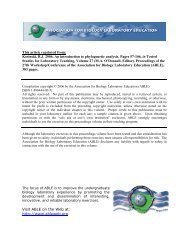Chapter 15 Variability and Selection in Natural Populations of Wood ...
Chapter 15 Variability and Selection in Natural Populations of Wood ...
Chapter 15 Variability and Selection in Natural Populations of Wood ...
Create successful ePaper yourself
Turn your PDF publications into a flip-book with our unique Google optimized e-Paper software.
252 Isopod <strong>Variability</strong><br />
1. Our students have quantified strength <strong>of</strong> selection by calculat<strong>in</strong>g a selection differential for each<br />
trait they have studied. Speed tends to have a relatively high selection differential (selection<br />
<strong>in</strong>tensity) while number <strong>of</strong> doral plates <strong>and</strong> antennal length have low selection differentials.<br />
Characters such as color, mass, <strong>and</strong> length vary with predator type. High selection <strong>in</strong>tensities<br />
should result <strong>in</strong> directional selections through time. Low selection <strong>in</strong>tensities should result <strong>in</strong> little<br />
change <strong>in</strong> the character as a result <strong>of</strong> selection.<br />
2. Different predator types are respond<strong>in</strong>g to different prey characters. Therefore, it is likely that<br />
selection <strong>in</strong>tensity for a character will depend on the type <strong>of</strong> predator. For example, a visual<br />
predator may select strongly aga<strong>in</strong>st conspicuously colored <strong>in</strong>dividuals. A predator that relies on a<br />
particular size <strong>and</strong> shaped feed<strong>in</strong>g apparatus may select aga<strong>in</strong>st a certa<strong>in</strong> size class <strong>of</strong> prey more<br />
strongly than aga<strong>in</strong>st other sizes.<br />
3. Our laboratory simulation limited selection to one factor, predation. In the wild, there are many<br />
selection factors which may result <strong>in</strong> the persistence <strong>of</strong> considerable trait variation. Fast animals<br />
may escape predation by may require more energy than their slower counterparts <strong>and</strong> be selected<br />
aga<strong>in</strong>st <strong>in</strong> times <strong>of</strong> nutrient shortage. Additionally. some <strong>of</strong> the characters that we studied may<br />
vary developmentally (e.g. body length). For example, strong selection aga<strong>in</strong>st small animals may<br />
not result <strong>in</strong> the elim<strong>in</strong>ation <strong>of</strong> small <strong>in</strong>dividuals. All sow bugs must be small before they become<br />
large.<br />
Acknowledgments<br />
This exercise was first designed, written <strong>and</strong> taught to students at U.C. Irv<strong>in</strong>e by Jeffrey<br />
Kaufmann, a former graduate student <strong>in</strong> the Department <strong>of</strong> Ecology <strong>and</strong> Evolutionary Biology.<br />
Instructions that Jeff prepared have been revised <strong>and</strong> rewritten several times by Rudi Berkelhamer<br />
<strong>and</strong>, most recently, by Timothy Watk<strong>in</strong>s, a recent graduate student at U.C. Irv<strong>in</strong>e. Over the years,<br />
many improvements <strong>in</strong> exercise procedures <strong>and</strong> <strong>in</strong>structions have been made as a result <strong>of</strong> helpful<br />
suggestions by both graduate teach<strong>in</strong>g assistants <strong>and</strong> undergraduate students.<br />
Literature Cited<br />
Barnes, R. D. 1980. Invertebrate Zoology. Fourth Edition. W. B. Saunders, Philadelphia, 1089 pages.<br />
Berkelhamer, R.C. <strong>and</strong> T.B. Watk<strong>in</strong>s. 1997. Exercise 6: <strong>Variability</strong> <strong>and</strong> selection <strong>in</strong> natural<br />
populations <strong>of</strong> wood lice. Pages 6-1 to 6-7, <strong>in</strong> Experimental Biology Laboratory Manual.<br />
Simon <strong>and</strong> Schuster Custom Publish<strong>in</strong>g, Needham Heights, Massachusetts, 63 pages.<br />
Campbell, D. R., N. M. Waser, M. V. Price, E. A. Lynch, <strong>and</strong> R. J. Mitchell. 1991. Components <strong>of</strong><br />
phenotypic selection: pollen export <strong>and</strong> flower corolla width <strong>in</strong> Ipomopsis aggregata.<br />
Evolution, 45:1458-1467.<br />
Darw<strong>in</strong>, C. 1859. The Orig<strong>in</strong> <strong>of</strong> Species. John Murray, London, 490 pages.<br />
Grant, P. R. 1986. Ecology <strong>and</strong> Evolution <strong>of</strong> Darw<strong>in</strong>ís F<strong>in</strong>ches. Pr<strong>in</strong>ceton University Press, New<br />
Jersey, 458 pages.<br />
Sokal, R.R. <strong>and</strong> F.J. Rohlf. 1995. Biometry. Third Edition. W.H. Freeman <strong>and</strong> Company, New<br />
York, 887 pages.
















